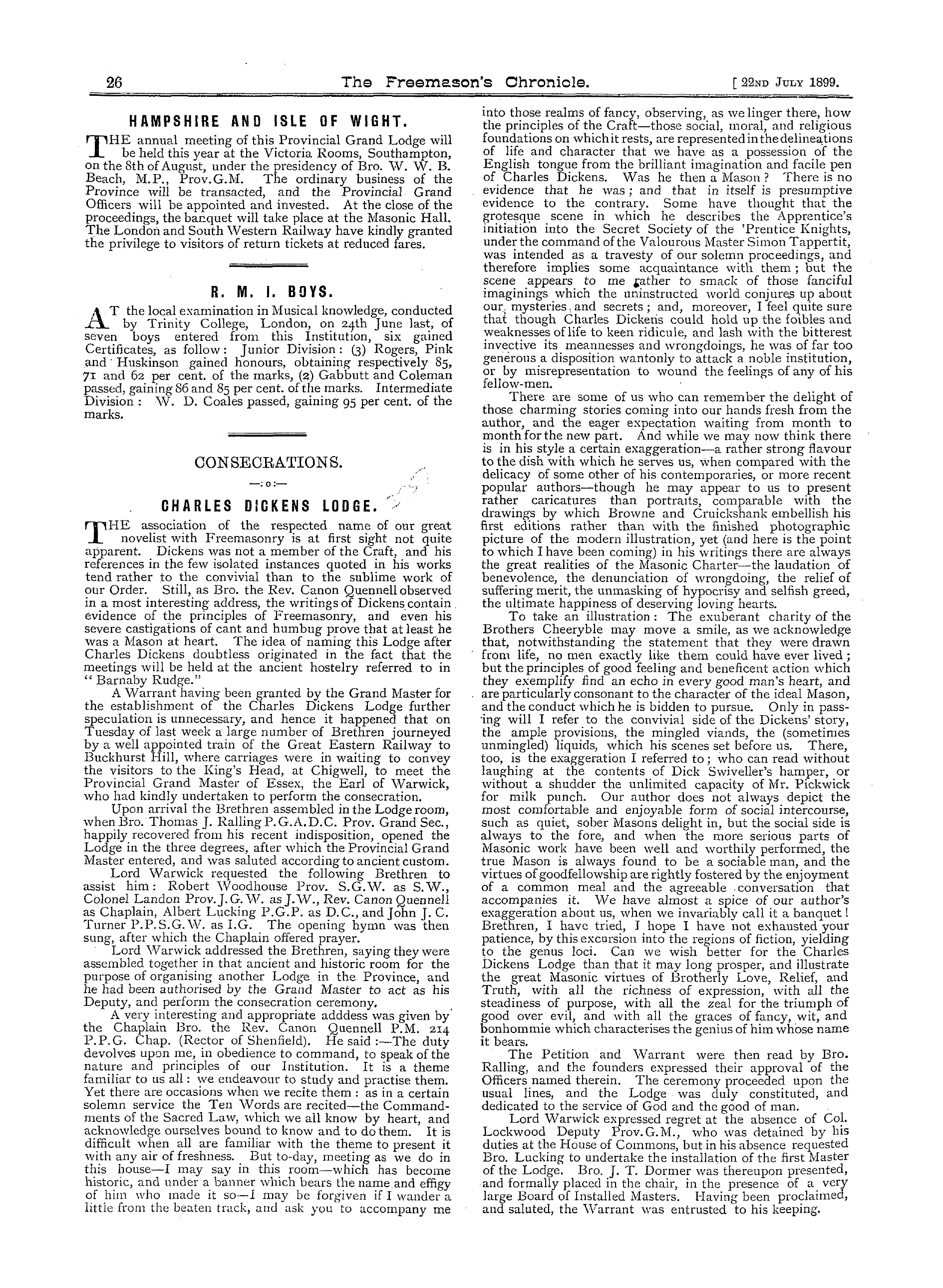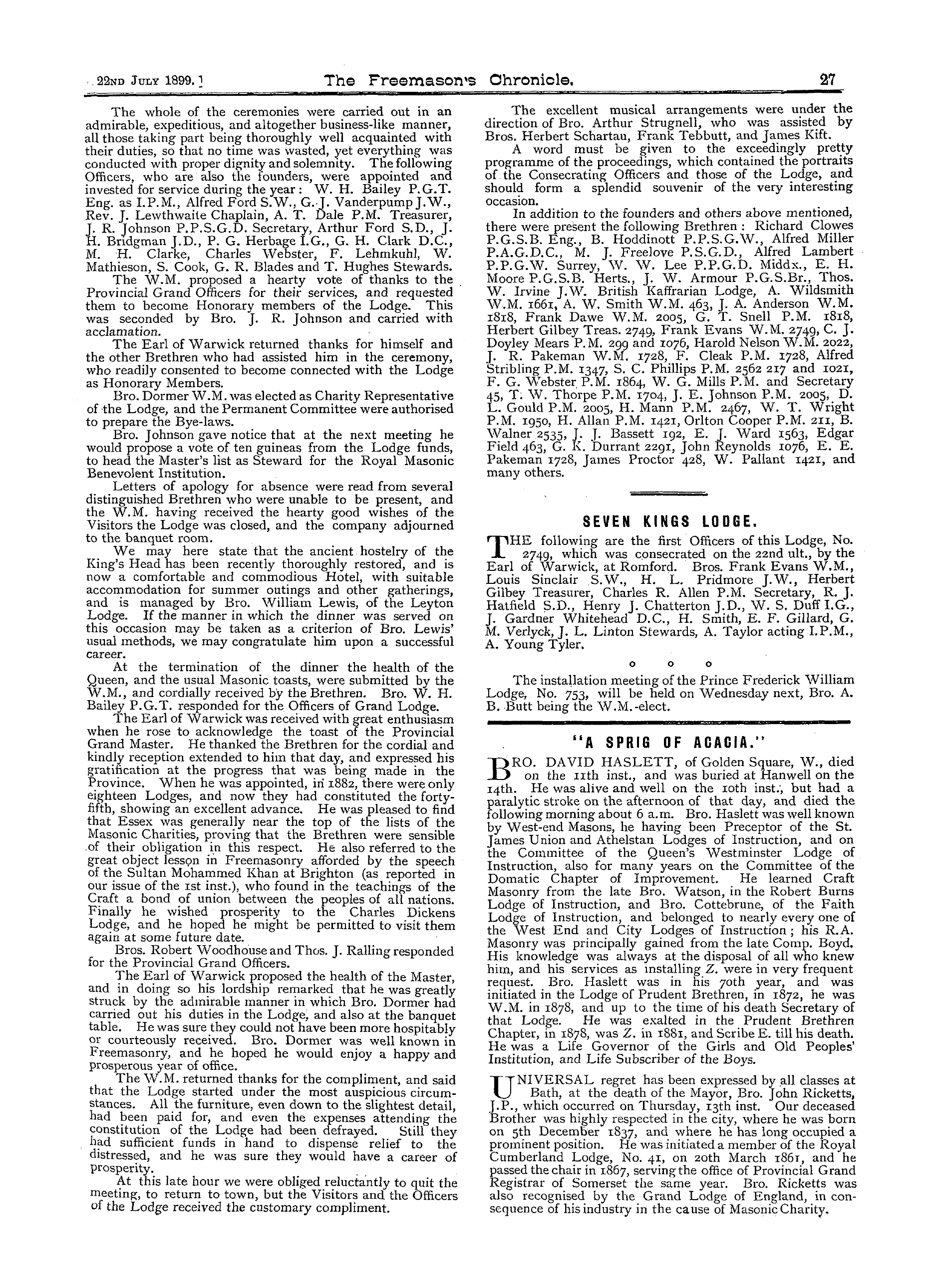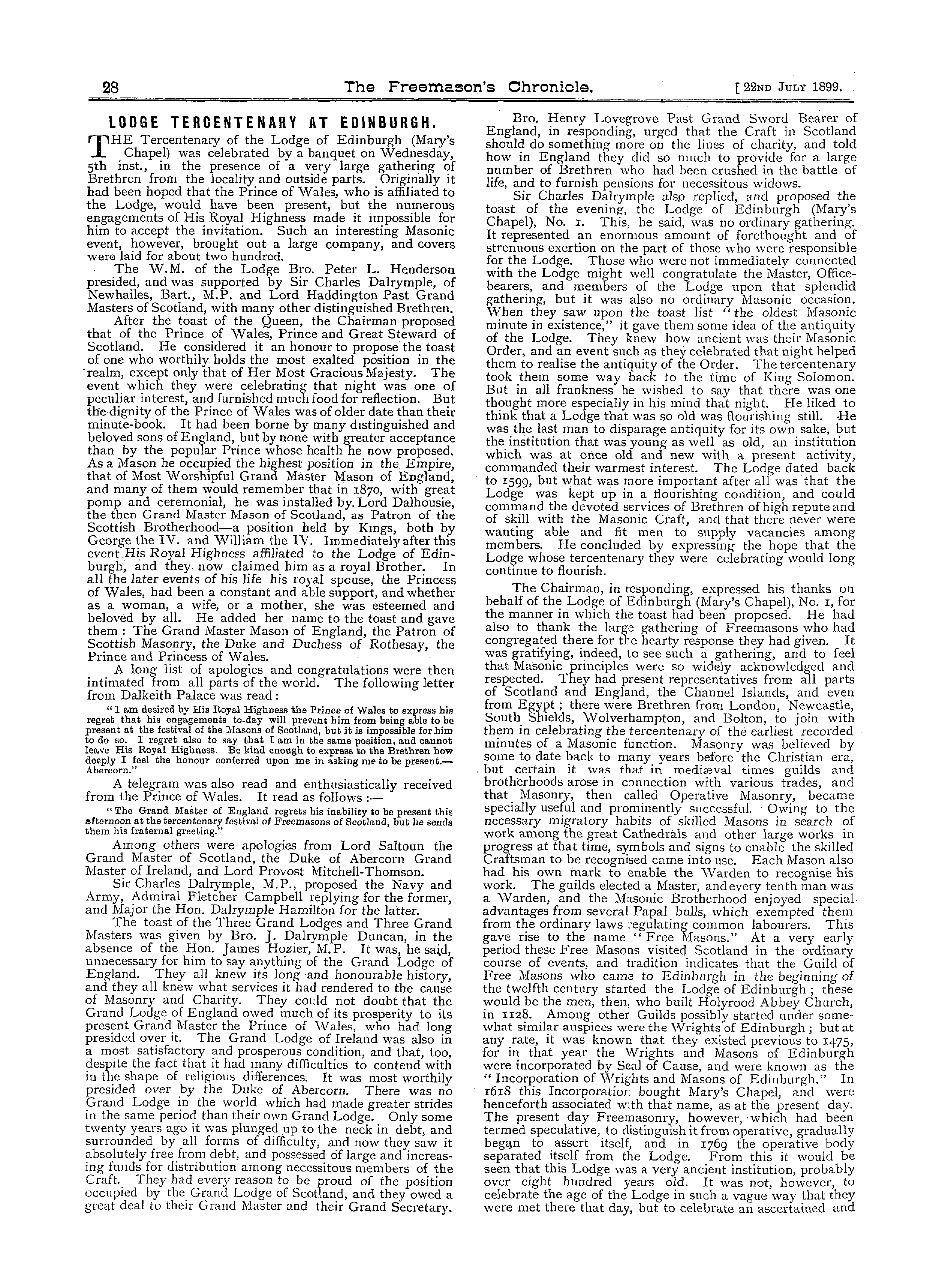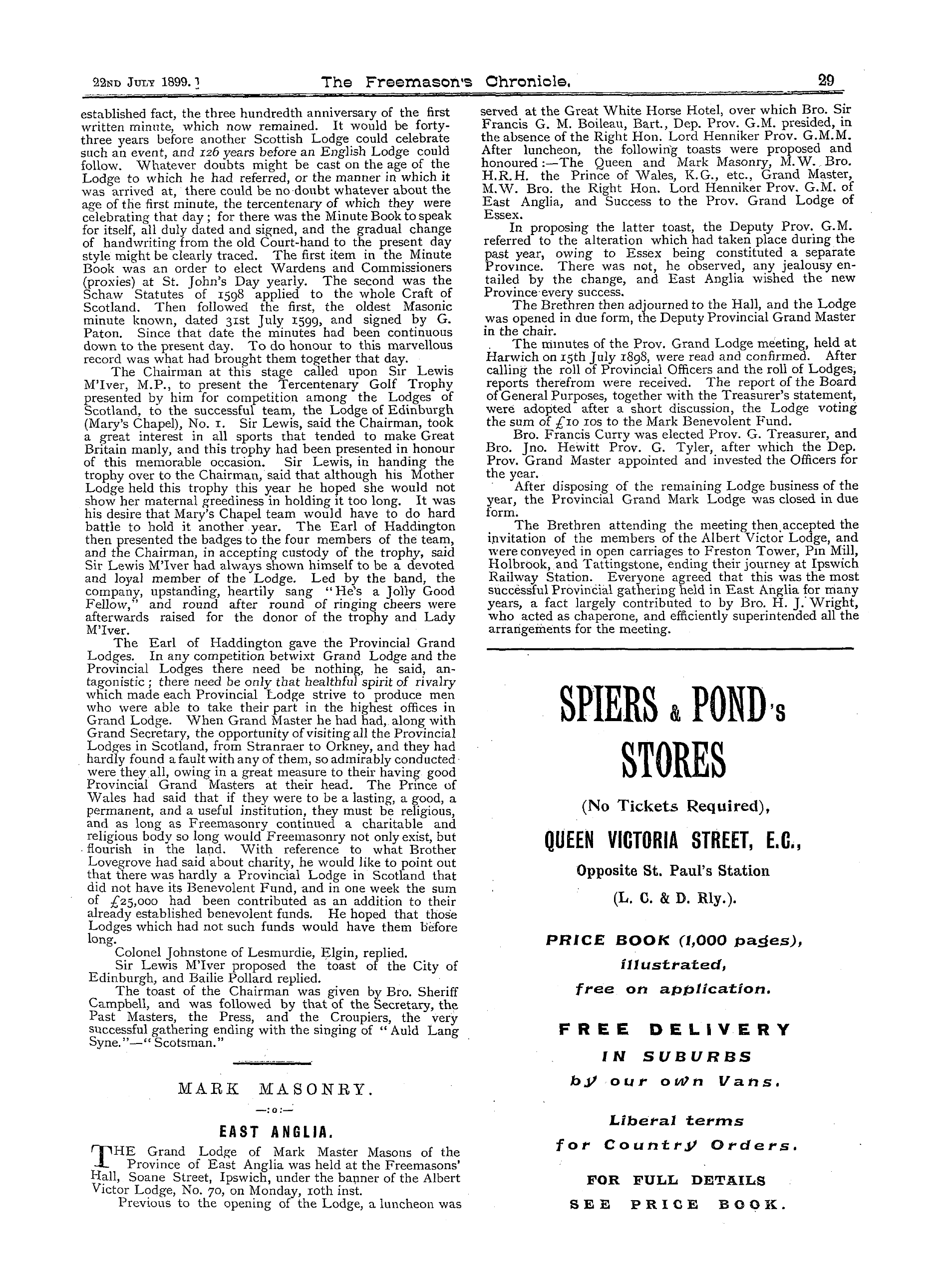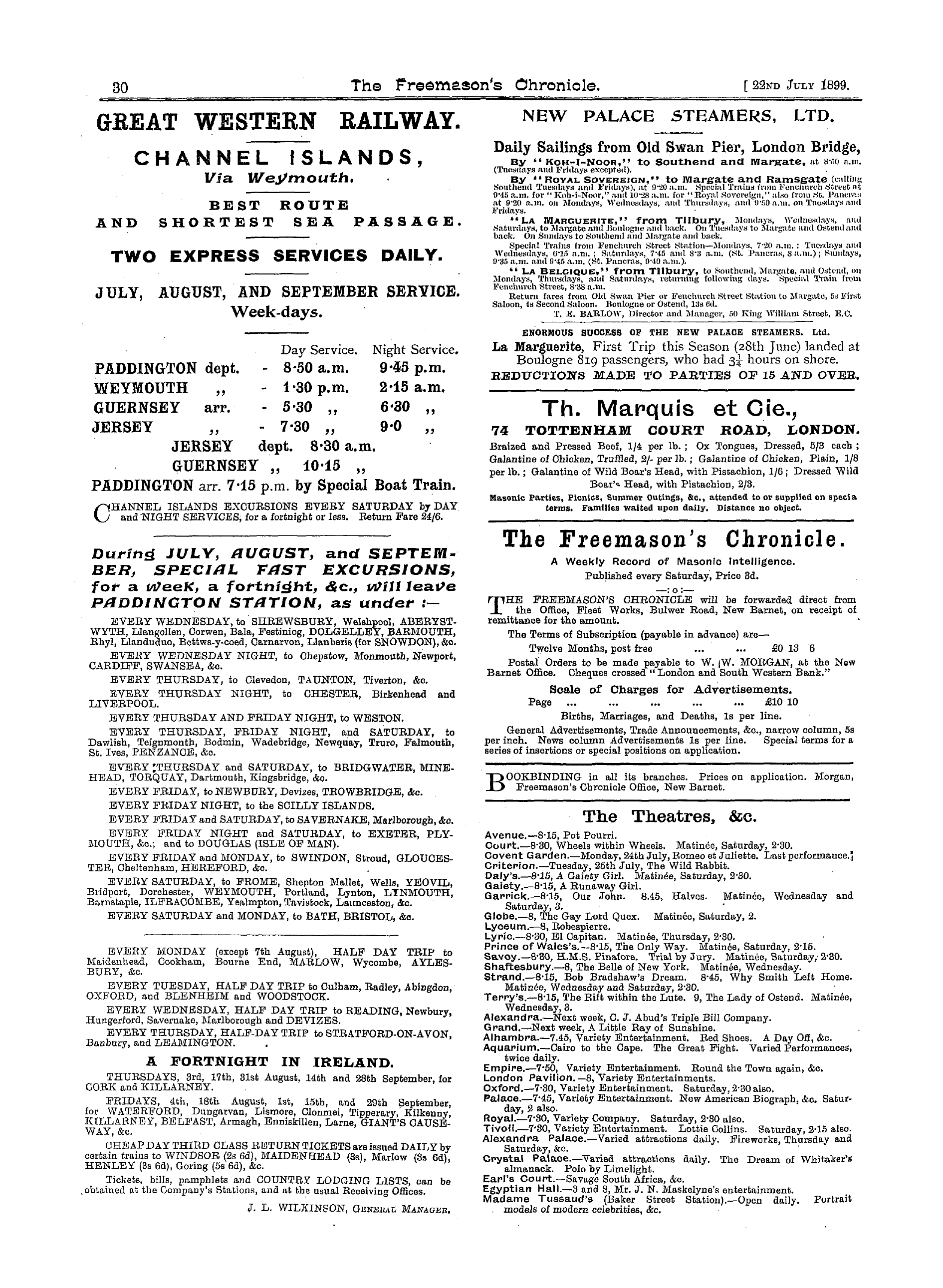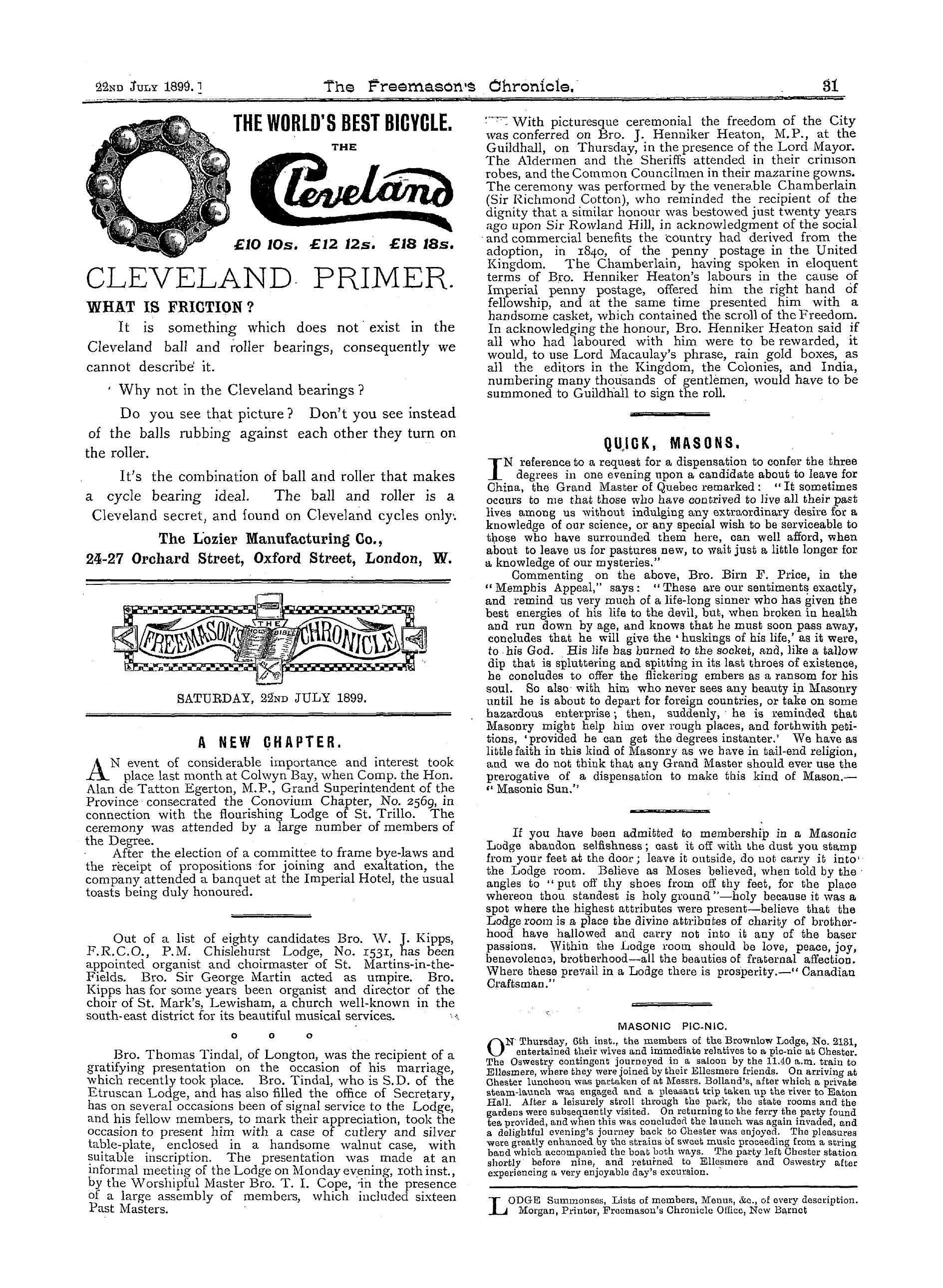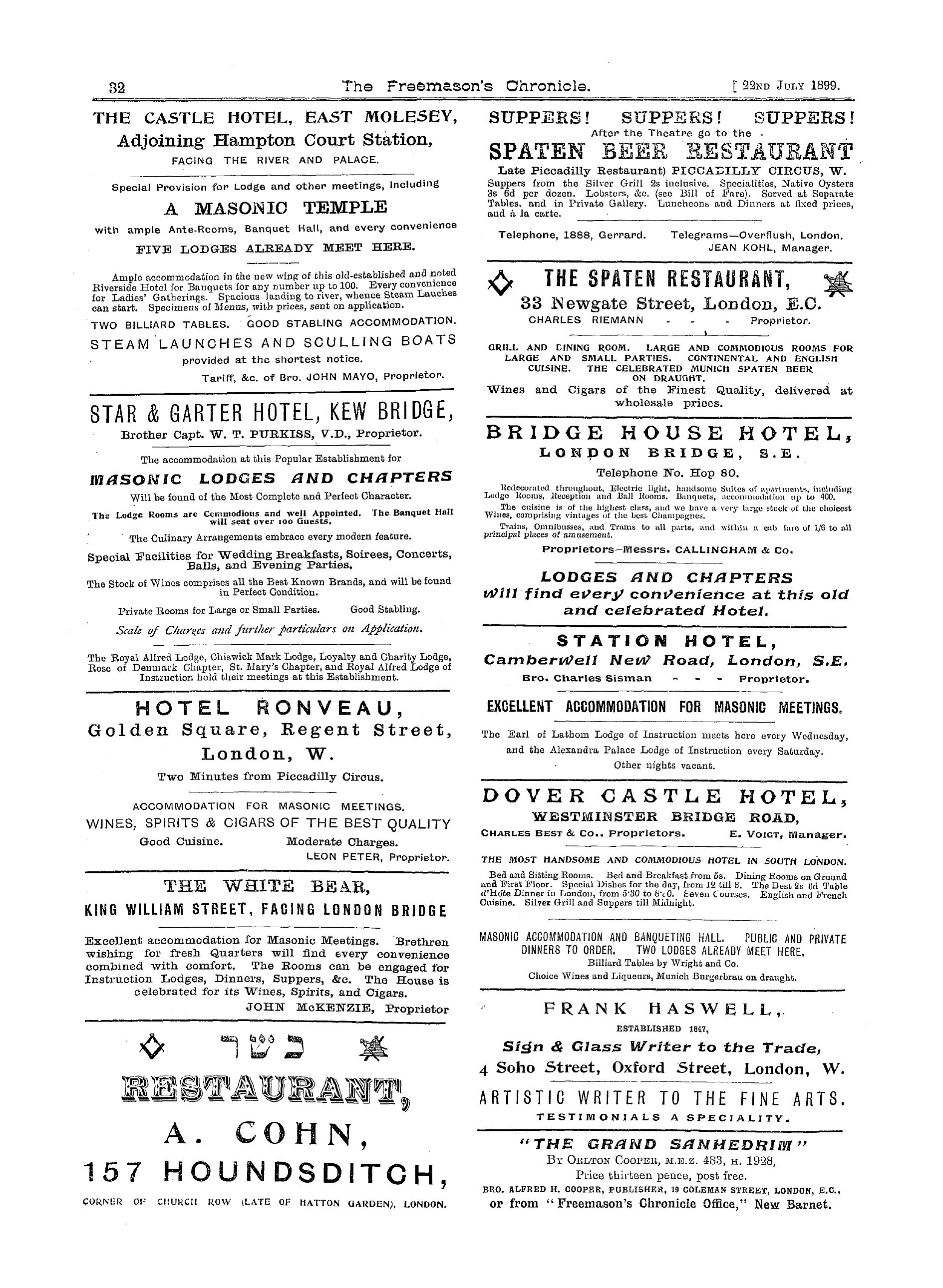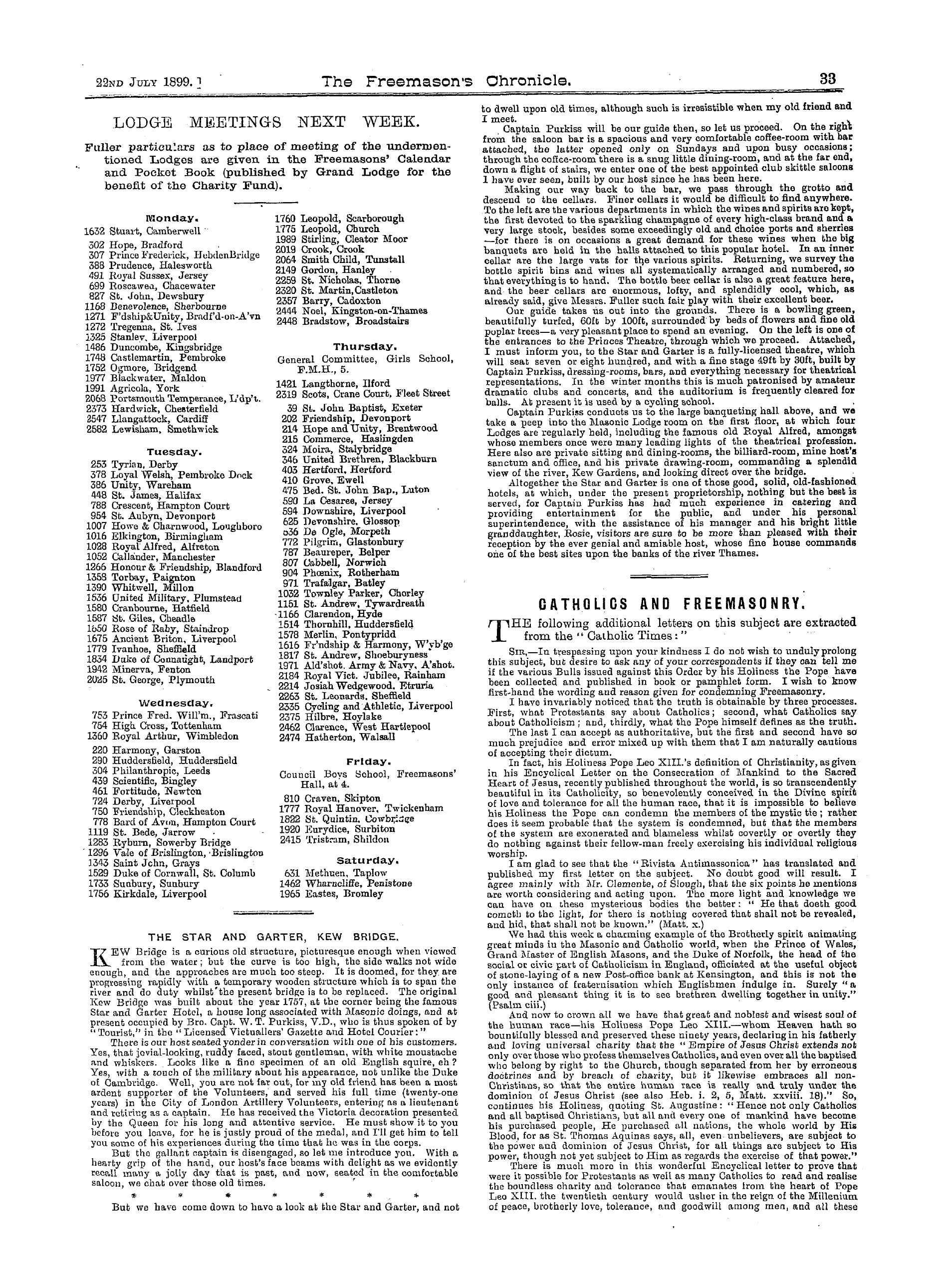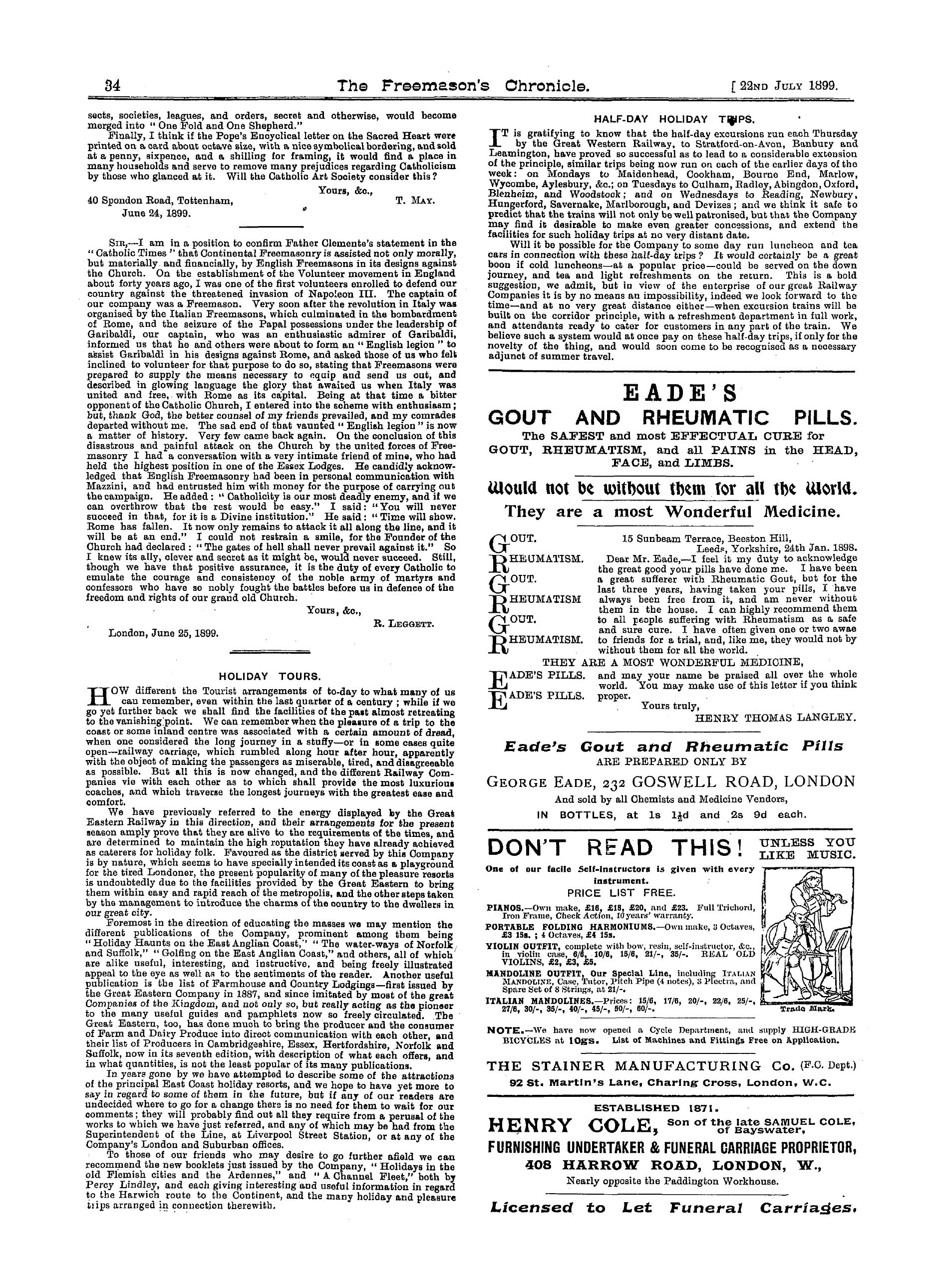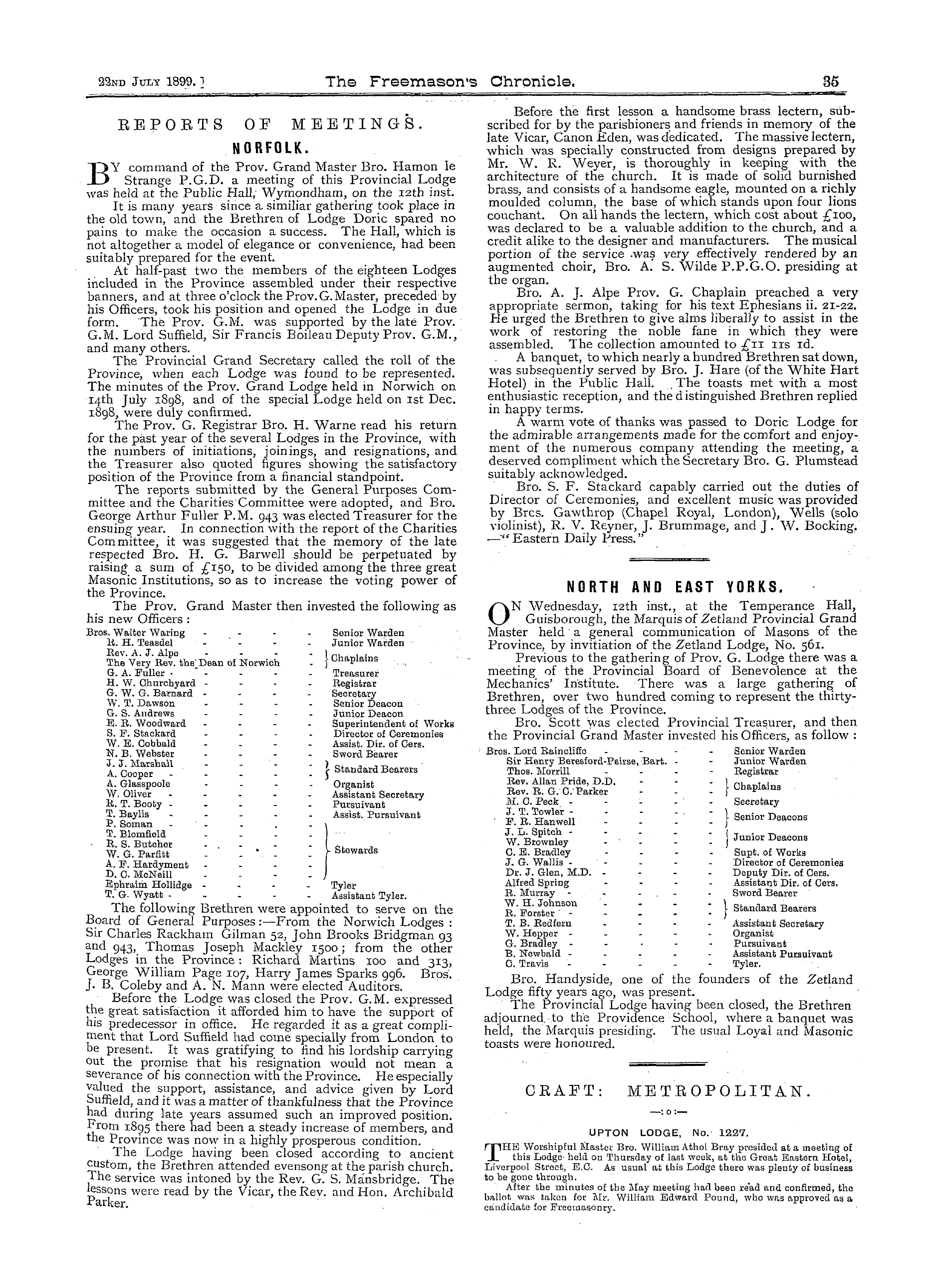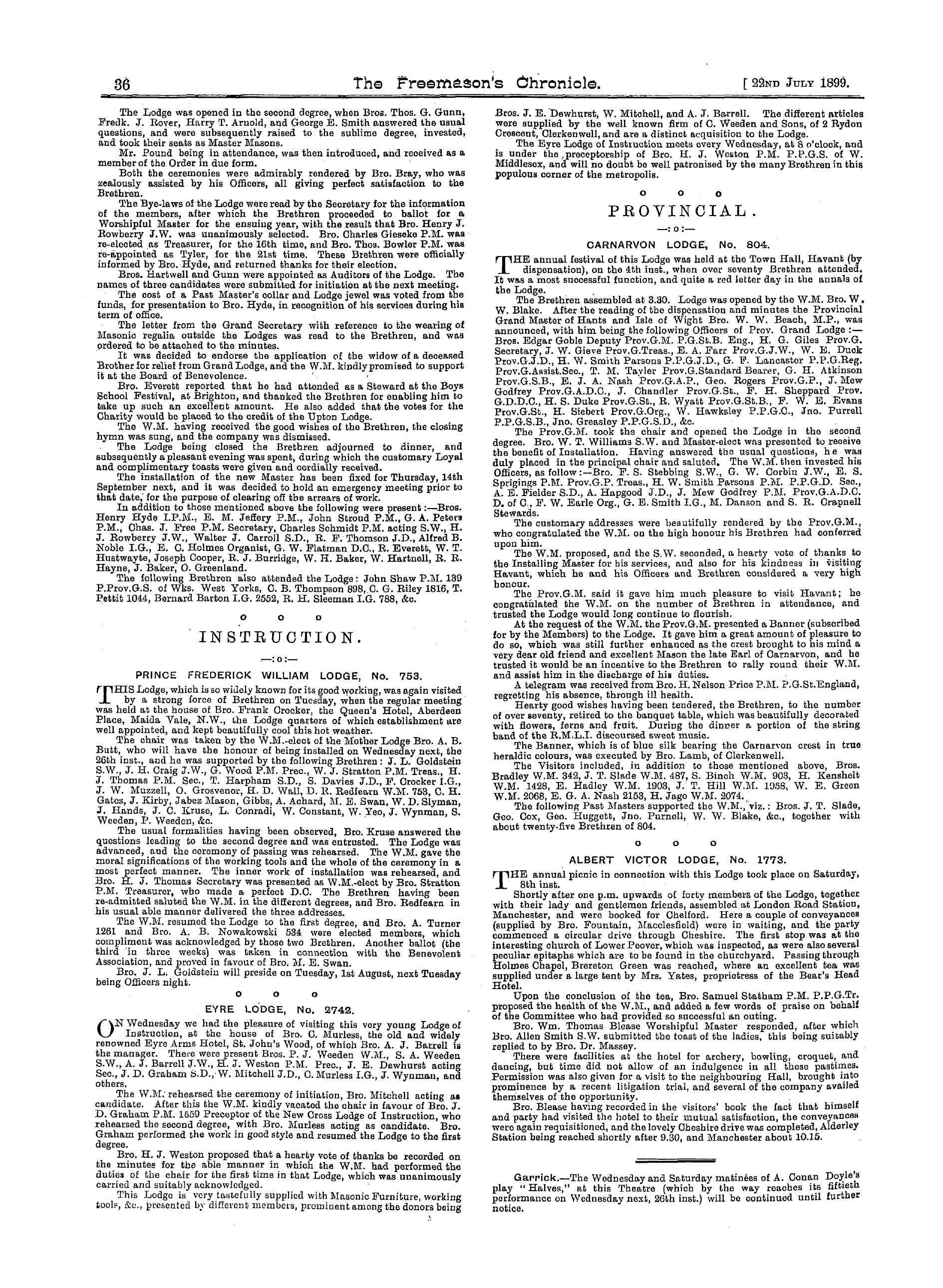-
Articles/Ads
Article LODGE TERCENTENARY AT EDINBURGH. Page 1 of 2 Article LODGE TERCENTENARY AT EDINBURGH. Page 1 of 2 →
Note: This text has been automatically extracted via Optical Character Recognition (OCR) software.
Lodge Tercentenary At Edinburgh.
LODGE TERCENTENARY AT EDINBURGH .
THE Tercentenary of the Lodge of Edinburgh ( Mary ' s Chapel ) was celebrated by a banquet on Wednesday , 5 th inst ., in the presence of a very large gathering of Brethren from the locality and outside parts . Originally it had been hoped that the Prince of Wales , who is affiliated to
the Lodge , would have been present , but the numerous engagements of His Royal Highness made it impossible for him to accept the invitation . Such an interesting Masonic event , however , brought out a large company , and covers were laid for about two hundred .
The W . M . of the Lodge Bro . Peter L . Henderson presided , and was supported by Sir Charles Dalrymple , of Newhailes , Bart ., M . P . and Lord Haddington Past Grand Masters of Scotland , with many other distinguished Brethren . After the toast of the Queen , the Chairman proposed
that of the Prince of Wales , Prince and Great Steward of Scotland . He considered it an honour to propose the toast of one who worthily holds the most exalted position in the realm , except only that of Her Most Gracious Majesty . The event which they were celebrating that night was one of
peculiar interest , and furnished much food for reflection . But the dignity of the Prince of Wales was of older date than their minute-book . It had been borne by many distinguished and beloved sons of England , but by none with greater acceptance than by the popular Prince whose health he now proposed .
As a Mason he occupied the highest position in the . Empire , that of Most Worshipful Grand Master Mason of England , and many of them would remember that in 1870 , with great pomp and ceremonial , he was installed by . Lord Dalhousie , the then Grand Master Mason of Scotland , as Patron of the
Scottish Brotherhood—a position held by Kings , both by George the IV . and William the IV . Immediately after this event His Royal Highness affiliated to the Lodge of Edinburgh , and they now claimed him as a royal Brother . In all the later events of his life his royal spouse , the Princess
of Wales , had been a constant and able support , and whether as a woman , a wife , or a mother , she was esteemed and beloved by all . He added her name to the toast and gave them : The Grand Master Mason of England , the Patron of Scottish Masonry , the Duke and Duchess of Rothesay , the Prince and Princess of Wales .
A long list of apologies and congratulations were then intimated from all parts of the world . The following letter from Dalkeith Palace was read : " I am desired by His Boyal Highness the Prince of Wales to express his regret that his engagements to-day will prevent him from being able to be
present at the festival of the Masons of Scotland , but it is impossible for him to do so . I regret also to say that I am in the same position , aud cannot leave His Royal Highness . Be kind enough to express to the Brethren how deeply I feel the honour conferred upon me in asking me to be present . — Abercorn . "
A telegram was also read and enthusiastically received from the Prince of Wales . It read as follows : — " The Grand Master of England regrets his inability to be present this afternoon at the tercentenary festival of Freemasons of Scotland , but he sends them his fraternal greeting . "
Among others were apologies from Lord Saltoun the Grand Master of Scotland , the Duke of Abercorn Grand Master of Ireland , and Lord Provost Mitchell-Thomson . Sir Charles Dalrymple , M . P ., proposed the Navy and Army , Admiral Fletcher Campbell replying for the former , and Major the Hon . Dalrymple Hamilton for the latter .
The toast of the Three Grand Lodges and Three Grand Masters was given by Bro . J . Dalrymple Duncan , in the absence of the Hon . James Hozier , M . P . It was , he sai . d , unnecessary for him to say anything of the Grand Lodge of England . They all knew its long and honourable history ,
and they all knew what services it had rendered to the cause of Masonry and Charity . They could not doubt that the Grand Lodge of England owed much of its prosperity to its present Grand Master the Prince of Wales , who had long presided over it . The Grand Lodge of Ireland was also in
a most satisfactory and prosperous condition , and that , too , despite the fact that it had many difficulties to contend with in the shape of religious differences . It was most worthily presided over by the Duke of Abercorn . There was no Grand Lodge in the world which had made greater strides in the same period than their own Grand Lodge . Only some
twenty years ago it was plunged up to the neck in debt , and surrounded by all forms of difficulty , and now they saw it absolutely free from debt , and possessed of large and increasing funds for distribution among necessitous members of the Craft . They had every reason to he proud of the position occupied by the Grand Lodge of Scotland , and they owed a great deal to their Grand Master and their Grand Secretary .
Lodge Tercentenary At Edinburgh.
Bro . Henry Lovegrove Past Grand Sword Bearer of England , in responding , urged that the Craft in Scotland should do something more on the lines of charity , and told how in England they did so much to provide for a large number of Brethren who had been crushed in the battle of
life , and to furnish pensions for necessitous widows . Sir Charles Dalrymple also replied , and proposed the toast of the evening , the Lodge of Edinburgh ( Mary ' s Chapel ) , No . 1 . This , he said , was no ordinary gathering . It represented an enormous amount of forethought and of
strenuous exertion on the part of those who were responsible for the Lodge . Those who were not immediately connected with the Lodge might well congratulate the Master , Officebearers , and members of the Lodge upon that splendid gathering , but it was also no ordinary Masonic occasion .
When they saw upon the toast list "the oldest Masonic minute in existence , " it gave them some idea of the antiquity of the Lodge . The } ' knew how ancient was their Masonic Order , and an event such as they celebrated that night helped them to realise the antiquity of the Order . The tercentenary
took them some way back to the time of King Solomon . But in all frankness he wished to say that there was one thought more especially in his mind that night . He liked to think that a Lodge that was so old was flourishing still . -He was the last man to disparage antiquity for its own sake , but
the institution that was young as well as old , an institution which was at once old and new with a present activity , commanded their warmest interest . The Lodge dated back to 1599 , but what was more important after all was that the Lodge was kept up in a flourishing condition , and could
command the devoted services of Brethren of high repute and of skill with the Masonic Craft , and that there never were wanting able and fit men to supply vacancies among members . He concluded by expressing the hope that the Lodge whose tercentenary they were celebrating would long continue to flourish .
The Chairman , in responding , expressed his thanks on behalf of the Lodge of Edinburgh ( Mary ' s Chapel ) , No . 1 , for the manner in which the toast had been proposed . He had also to thank the large gathering of Freemasons who had congregated there for the hearty response they had given . It
was gratifying , indeed , to see such a gathering , and to feel that Masonic principles were so widely acknowledged and respected . They had present representatives from all parts of Scotland and England , the Channel Islands , and even from Egypt ; there were Brethren from London , Newcastle ,
South Shields , Wolverhampton , and Bolton , to join with them in celebrating the tercentenary of the earliest recorded minutes of a Masonic function . Masonry was believed by some to date back to many years before the Christian era , but certain it was that in mediaeval times guilds and
brotherhoods arose in connection with various trades , and that Masonry , then called Operative Masonry , became specially useful and prominently successful . Owing to the necessary migratory habits of skilled Masons in search of work among the great Cathedrals and other large works in
progress at that time , symbols and signs to enable the skilled Craftsman to be recognised came into use . Each Mason also had his own mark to enable the Warden to recognise his work . The guilds elected a Master , and every tenth man was a Warden , and the Masonic Brotherhood enjoyed special
advantages from several Papal bulls , which exempted them from the ordinary laws regulating common labourers . This gave rise to the name " Free Masons . " At a very early period these Free Masons visited Scotland in the ordinary course of events , and tradition indicates that the Guild of
Free Masons who came to Edinburgh in the beginning of the twelfth century started the Lodge of Edinburgh ; these would be the men , then , who built Holyrood Abbey Church , in 1128 . Among other Guilds possibly started under somewhat similar auspices were the Wrights of Edinburgh ; but at
any rate , it was known that they existed previous to 1475 , for in that year the Wrights and Masons of Edinburgh were incorporated by Seal of Cause , and were known as the " Incorporation of Wrights and Masons of Edinburgh . " In 1618 this Incorporation bought Mary ' s Chapel , and were
henceforth associated with that name , as at the present day . The present day Freemasonry , however , which had been termed speculative , to distinguish it from operative , gradually began to assert itself , and in 1769 the operative body
separated itself from the Lodge . From this it would be seen that this Lodge was a very ancient institution , probably over eight hundred years old . It was not , however , to celebrate the age of the Lodge in such a vague way that they were met there that day , but to celebrate an ascertained and
Note: This text has been automatically extracted via Optical Character Recognition (OCR) software.
Lodge Tercentenary At Edinburgh.
LODGE TERCENTENARY AT EDINBURGH .
THE Tercentenary of the Lodge of Edinburgh ( Mary ' s Chapel ) was celebrated by a banquet on Wednesday , 5 th inst ., in the presence of a very large gathering of Brethren from the locality and outside parts . Originally it had been hoped that the Prince of Wales , who is affiliated to
the Lodge , would have been present , but the numerous engagements of His Royal Highness made it impossible for him to accept the invitation . Such an interesting Masonic event , however , brought out a large company , and covers were laid for about two hundred .
The W . M . of the Lodge Bro . Peter L . Henderson presided , and was supported by Sir Charles Dalrymple , of Newhailes , Bart ., M . P . and Lord Haddington Past Grand Masters of Scotland , with many other distinguished Brethren . After the toast of the Queen , the Chairman proposed
that of the Prince of Wales , Prince and Great Steward of Scotland . He considered it an honour to propose the toast of one who worthily holds the most exalted position in the realm , except only that of Her Most Gracious Majesty . The event which they were celebrating that night was one of
peculiar interest , and furnished much food for reflection . But the dignity of the Prince of Wales was of older date than their minute-book . It had been borne by many distinguished and beloved sons of England , but by none with greater acceptance than by the popular Prince whose health he now proposed .
As a Mason he occupied the highest position in the . Empire , that of Most Worshipful Grand Master Mason of England , and many of them would remember that in 1870 , with great pomp and ceremonial , he was installed by . Lord Dalhousie , the then Grand Master Mason of Scotland , as Patron of the
Scottish Brotherhood—a position held by Kings , both by George the IV . and William the IV . Immediately after this event His Royal Highness affiliated to the Lodge of Edinburgh , and they now claimed him as a royal Brother . In all the later events of his life his royal spouse , the Princess
of Wales , had been a constant and able support , and whether as a woman , a wife , or a mother , she was esteemed and beloved by all . He added her name to the toast and gave them : The Grand Master Mason of England , the Patron of Scottish Masonry , the Duke and Duchess of Rothesay , the Prince and Princess of Wales .
A long list of apologies and congratulations were then intimated from all parts of the world . The following letter from Dalkeith Palace was read : " I am desired by His Boyal Highness the Prince of Wales to express his regret that his engagements to-day will prevent him from being able to be
present at the festival of the Masons of Scotland , but it is impossible for him to do so . I regret also to say that I am in the same position , aud cannot leave His Royal Highness . Be kind enough to express to the Brethren how deeply I feel the honour conferred upon me in asking me to be present . — Abercorn . "
A telegram was also read and enthusiastically received from the Prince of Wales . It read as follows : — " The Grand Master of England regrets his inability to be present this afternoon at the tercentenary festival of Freemasons of Scotland , but he sends them his fraternal greeting . "
Among others were apologies from Lord Saltoun the Grand Master of Scotland , the Duke of Abercorn Grand Master of Ireland , and Lord Provost Mitchell-Thomson . Sir Charles Dalrymple , M . P ., proposed the Navy and Army , Admiral Fletcher Campbell replying for the former , and Major the Hon . Dalrymple Hamilton for the latter .
The toast of the Three Grand Lodges and Three Grand Masters was given by Bro . J . Dalrymple Duncan , in the absence of the Hon . James Hozier , M . P . It was , he sai . d , unnecessary for him to say anything of the Grand Lodge of England . They all knew its long and honourable history ,
and they all knew what services it had rendered to the cause of Masonry and Charity . They could not doubt that the Grand Lodge of England owed much of its prosperity to its present Grand Master the Prince of Wales , who had long presided over it . The Grand Lodge of Ireland was also in
a most satisfactory and prosperous condition , and that , too , despite the fact that it had many difficulties to contend with in the shape of religious differences . It was most worthily presided over by the Duke of Abercorn . There was no Grand Lodge in the world which had made greater strides in the same period than their own Grand Lodge . Only some
twenty years ago it was plunged up to the neck in debt , and surrounded by all forms of difficulty , and now they saw it absolutely free from debt , and possessed of large and increasing funds for distribution among necessitous members of the Craft . They had every reason to he proud of the position occupied by the Grand Lodge of Scotland , and they owed a great deal to their Grand Master and their Grand Secretary .
Lodge Tercentenary At Edinburgh.
Bro . Henry Lovegrove Past Grand Sword Bearer of England , in responding , urged that the Craft in Scotland should do something more on the lines of charity , and told how in England they did so much to provide for a large number of Brethren who had been crushed in the battle of
life , and to furnish pensions for necessitous widows . Sir Charles Dalrymple also replied , and proposed the toast of the evening , the Lodge of Edinburgh ( Mary ' s Chapel ) , No . 1 . This , he said , was no ordinary gathering . It represented an enormous amount of forethought and of
strenuous exertion on the part of those who were responsible for the Lodge . Those who were not immediately connected with the Lodge might well congratulate the Master , Officebearers , and members of the Lodge upon that splendid gathering , but it was also no ordinary Masonic occasion .
When they saw upon the toast list "the oldest Masonic minute in existence , " it gave them some idea of the antiquity of the Lodge . The } ' knew how ancient was their Masonic Order , and an event such as they celebrated that night helped them to realise the antiquity of the Order . The tercentenary
took them some way back to the time of King Solomon . But in all frankness he wished to say that there was one thought more especially in his mind that night . He liked to think that a Lodge that was so old was flourishing still . -He was the last man to disparage antiquity for its own sake , but
the institution that was young as well as old , an institution which was at once old and new with a present activity , commanded their warmest interest . The Lodge dated back to 1599 , but what was more important after all was that the Lodge was kept up in a flourishing condition , and could
command the devoted services of Brethren of high repute and of skill with the Masonic Craft , and that there never were wanting able and fit men to supply vacancies among members . He concluded by expressing the hope that the Lodge whose tercentenary they were celebrating would long continue to flourish .
The Chairman , in responding , expressed his thanks on behalf of the Lodge of Edinburgh ( Mary ' s Chapel ) , No . 1 , for the manner in which the toast had been proposed . He had also to thank the large gathering of Freemasons who had congregated there for the hearty response they had given . It
was gratifying , indeed , to see such a gathering , and to feel that Masonic principles were so widely acknowledged and respected . They had present representatives from all parts of Scotland and England , the Channel Islands , and even from Egypt ; there were Brethren from London , Newcastle ,
South Shields , Wolverhampton , and Bolton , to join with them in celebrating the tercentenary of the earliest recorded minutes of a Masonic function . Masonry was believed by some to date back to many years before the Christian era , but certain it was that in mediaeval times guilds and
brotherhoods arose in connection with various trades , and that Masonry , then called Operative Masonry , became specially useful and prominently successful . Owing to the necessary migratory habits of skilled Masons in search of work among the great Cathedrals and other large works in
progress at that time , symbols and signs to enable the skilled Craftsman to be recognised came into use . Each Mason also had his own mark to enable the Warden to recognise his work . The guilds elected a Master , and every tenth man was a Warden , and the Masonic Brotherhood enjoyed special
advantages from several Papal bulls , which exempted them from the ordinary laws regulating common labourers . This gave rise to the name " Free Masons . " At a very early period these Free Masons visited Scotland in the ordinary course of events , and tradition indicates that the Guild of
Free Masons who came to Edinburgh in the beginning of the twelfth century started the Lodge of Edinburgh ; these would be the men , then , who built Holyrood Abbey Church , in 1128 . Among other Guilds possibly started under somewhat similar auspices were the Wrights of Edinburgh ; but at
any rate , it was known that they existed previous to 1475 , for in that year the Wrights and Masons of Edinburgh were incorporated by Seal of Cause , and were known as the " Incorporation of Wrights and Masons of Edinburgh . " In 1618 this Incorporation bought Mary ' s Chapel , and were
henceforth associated with that name , as at the present day . The present day Freemasonry , however , which had been termed speculative , to distinguish it from operative , gradually began to assert itself , and in 1769 the operative body
separated itself from the Lodge . From this it would be seen that this Lodge was a very ancient institution , probably over eight hundred years old . It was not , however , to celebrate the age of the Lodge in such a vague way that they were met there that day , but to celebrate an ascertained and

